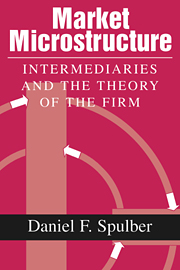Book contents
- Frontmatter
- Contents
- Preface and acknowledgments
- Introduction
- Part I Market microstructure and the intermediation theory of the firm
- Part II Competition and market equilibrium
- Part III Intermediation versus decentralized trade
- 5 Matching and intermediation by firms
- 6 Search and intermediation by firms
- Part IV Intermediation under asymmetric information
- Part V Intermediation and transaction-cost theory
- Part VI Intermediation and agency theory
- Conclusion
- References
- Index
6 - Search and intermediation by firms
Published online by Cambridge University Press: 18 December 2009
- Frontmatter
- Contents
- Preface and acknowledgments
- Introduction
- Part I Market microstructure and the intermediation theory of the firm
- Part II Competition and market equilibrium
- Part III Intermediation versus decentralized trade
- 5 Matching and intermediation by firms
- 6 Search and intermediation by firms
- Part IV Intermediation under asymmetric information
- Part V Intermediation and transaction-cost theory
- Part VI Intermediation and agency theory
- Conclusion
- References
- Index
Summary
In the Walrasian market model, consumers, suppliers and firms are price takers, and the selection of market-clearing prices is ascribed to an exogenous Walrasian auctioneer. In practice, however, while some firms act as price takers, many other firms act as price makers, often setting both output prices and input prices to balance their purchases and sales. Certainly one cannot enter a store or view an advertisement without observing that firms post prices for their products. Furthermore, both large and small companies bid for capital, labor, manufactured inputs, resources, and technology. By setting ask and bid prices, wholesale and retail firms act as intermediaries, coordinate transactions, clear markets, and establish relative prices in the economy; see Spulber (1996b). Manufacturing firms often combine production with related market-making activities. These observations suggest that markets are created and operated through the price-setting activities of firms. The question is how market equilibrium with endogenous price setting by firms differs from the frictionless Walrasian framework.
The purpose of this chapter is to present a search model that allows an explicit comparison between market equilibrium with endogenous price setting by competing intermediaries and the traditional supply and demand model. I examine market making by price-setting firms with consumers searching for the lowest ask price and suppliers searching for the highest bid price. Contrary to the law of one price and consistent with some search models, equilibrium with price setting by firms features nondegenerate distributions of buyer and seller prices.
- Type
- Chapter
- Information
- Market MicrostructureIntermediaries and the Theory of the Firm, pp. 140 - 168Publisher: Cambridge University PressPrint publication year: 1999



